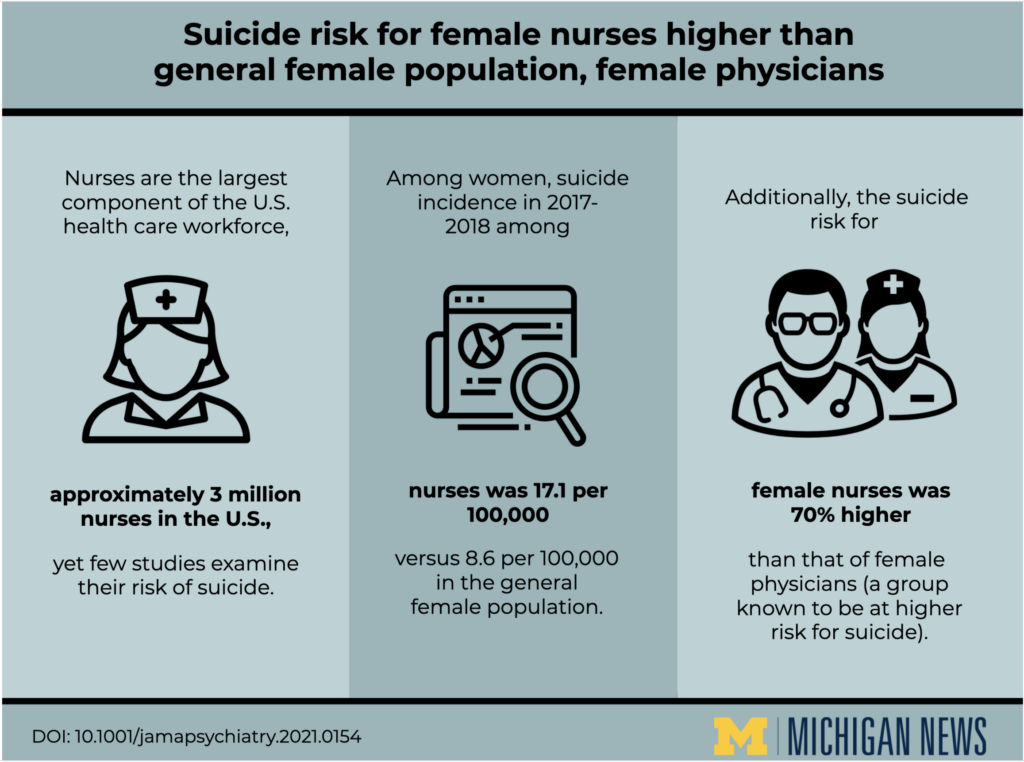“Much higher than I expected…”
Female nurses are roughly twice as likely to die by suicide than the general female population and 70 percent more likely than female physicians, according to a University of Michigan study examining suicide among physicians and nurses.
“It’s much higher than I expected,” says study lead author Matthew Davis, associate professor at the U-M School of Nursing. “The takeaway for me is we’ve focused so much on physician welfare that, historically, we haven’t paid enough attention to this huge workforce that, based on our data, is at much higher risk.”
There are roughly 3 million nurses working in the United States, making it the country’s largest health-care workforce — 85 percent of whom are women.
Davis says the extraordinary demands that COVID-19 has placed on women – from homeschooling to finding child care – intensifies the stress these nurses experience. The current study did not include data from the pandemic, which means these numbers could be even higher now, he says.
Two key issues of concern
Nurses and physicians face many similar risk factors for suicide, but in nurses those risk factors are potentially exacerbated by long hours and less automony, says co-author Christopher Friese, the Elizabeth Tone Hosmer Professor of Nursing and professor of health management and policy at the U-M School of Public Health.
“I’m worried about two key issues in today’s workplace,” says Friese, who has more than 20 years experience in nursing. “First, health-care systems are placing increased demands on nurses, physicians and other health-care workers. Even before COVID, nurses reported substantial workplace stressors, including reduced staffing, increased complexity of care and additional bureaucratic tasks. Nurses have been working nonstop caring for seriously ill patients and facing their own exposure to this virus.
“Second, the nurses I work with routinely face tougher challenges at home that place added stress on them, such as caregiving for children or parents. You put the workplace and home stressors together and it’s no surprise that nurses are struggling. I worry that without concerted action, things may get worse before they get better.”
We need a well-functioning work force
Study co-author Julie Bynum, the Margaret Terpenning Collegiate Professor of Internal Medicine and professor of geriatric and palliative medicine at Michigan Medicine, says she has been struck by the widespread use of this data to better understand women’s health.
“But until our recent paper, it has not been used to understand the health of these women — as nurses — who are central to a well-functioning health-care workforce,” she says. “As the population ages, the need for both bedside nurses and nurses who take on roles as advanced practitioners will become ever more crucial.”
Among male nurses, the risk of suicide is no higher than the general male population, the study found. But the researchers were surprised by the high number of suicides among female nurses compared to physicians, and they found no difference in the suicide rates of physicians and the general public, which differs from previous studies.
Overcoming the stigma
There are a couple possible reasons for this, they say: It could be that the physician studies aren’t capturing the entire picture — most are small, single-state studies and dated. Or, perhaps, wellness programs targeting physicians have worked. Finally, medical examiners may be undercoding this cause of death for physician colleagues.Friese says one major impediment to seeking help is the stigma that people fear for their livelihoods.
“Employers need to make it easy for nurses, doctors, and other health-care workers who are struggling to access the help they need,” he says.
The study findings illuminate the need for high-quality wellness programs for nurses: Nurses are 90 percent more likely to experience on-the-job problems and 20-30 percent more likely to be depressed than the general population.
More than half of all suicides among the general population are the result of gunshot wounds. Among nurses, however, overdose is more common. And both nurses and physicians are more likely to have antidepressants, benzodiazepines, barbiturates, and opiates in their system, which suggests a need for greater behavioral health awareness among health-care professionals, the researchers say.
“We looked at this because people who work in health care have easier access to medications and know how to use them to overdose, which also increases their risk,” Davis says. “Simply not having a way to do it may be enough of a deterrent to suicide.”
Davis and colleagues believe the study, which was published online April 14 in JAMA Psychiatry, is the most comprehensive to data on suicide among nurses. They analyzed mortality data from the Centers for Disease Control from 2007-18, identifying 2,374 suicides among nurses, 857 among physicians, and 156,141 in the general population. Among its limitations, the study used pre-collected data and many of its measures relied on interpretation of medical examiner reports.





Karen Brown, PhD RN CNE - 1977
I would be very interested to see data from 2020-2021 analyzed on nurse suicides. This past year has been unbelievably difficult for nurses nationwide. Thank you for publishing this story and shedding light on a serious problem in our healthcare system.
Reply
J B - 12
We may also want to consider males nurses as well. It appears depending on were you get your data, male nurses are approximately 3-4 times more likely to commit suicide than their female colleagues. Seems pretty significant.
Reply
N L - 1991
Regarding the comment about male nurses’ suicide rate. Read the article again. The rate was clearly found to be much lower than female nurses.
Reply
Games_Amoung Games_Amoung - 1994
Study co-author Julie Bynum, the Margaret Terpenning Collegiate Professor of Internal Medicine and professor of geriatric and palliative medicine at Michigan Medicine, says she has been struck by the widespread use of this data to better understand women s health. Among male nurses, the risk of suicide is no higher than the general male population, the study found. But the researchers were surprised by the high number of suicides among female nurses compared to physicians, and they found no difference in the suicide rates of physicians and the general public, which differs from previous studies.
Reply
Maureen Schilder - 1983 BSN from University of Rhode Island
What is maddening about this all – is there is a very clear solution to this problem of burnout/overstressed RN’s. Make BSN programs for RN’s college/university tuition awarded to hundreds of thousands applicants who have proven throught their grades in highschool, or other tests if post highschool graduation age, that they can successfully complete a BSN program … Problem solved.
The Phillipines and South Africa have some of the best nurses that come to the USA to work, and they ONLY offer BSN programs there. If tuition were not an issue, then the USA could have the quality of education the Phillipines & South Africa offers their students. ANd there would be no shortage; drastically reducing the stress nurses work under. But, my fear is the ‘Corporate Healthcare for Profit’ – main goal is to reduce cost of staffing – and because the USA is the only country that will neither pay for healthcare, nor education (past highschool) we are doomed … Is it any wonder the entire country is falling apart when eduication & healthcare are “for profit” institutions. This must change, or else USA will soon be reduced to 3rd World status
Reply